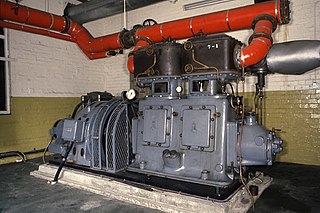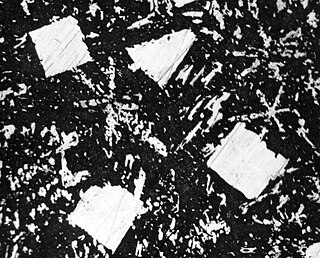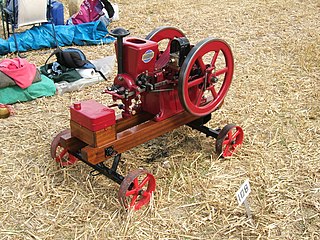

A ring oiler or oil ring is a form of oil-lubrication system for bearings.

Lubrication is the process or technique of using a lubricant to reduce friction and/or wear in a contact between two surfaces. The study of lubrication is a discipline in the field of tribology.

A bearing is a machine element that constrains relative motion to only the desired motion, and reduces friction between moving parts. The design of the bearing may, for example, provide for free linear movement of the moving part or for free rotation around a fixed axis; or, it may prevent a motion by controlling the vectors of normal forces that bear on the moving parts. Most bearings facilitate the desired motion by minimizing friction. Bearings are classified broadly according to the type of operation, the motions allowed, or to the directions of the loads (forces) applied to the parts.
Ring oilers were used for medium-speed applications with moderate loads, during the first half of the 20th century. These represented the later years of the stationary steam engine, and the beginnings of the high-speed steam engine, the internal combustion oil engine [1] and electrical generating equipment. [2] Before this time plain bearings were lubricated by drip-feed oil cups or manually by an engine tender with an oil can. As speeds or bearing loads later increased, forced pressure lubrication became more prevalent and the ring oiler fell from use.

Stationary steam engines are fixed steam engines used for pumping or driving mills and factories, and for power generation. They are distinct from locomotive engines used on railways, traction engines for heavy steam haulage on roads, steam cars, agricultural engines used for ploughing or threshing, marine engines, and the steam turbines used as the mechanism of power generation for most nuclear power plants.

High-speed steam engines were one of the final developments of the stationary steam engine. They ran at a high speed, of several hundred rpm, which was needed by tasks such as electricity generation.
The crude oil engine is a type of internal combustion engine similar to the hot bulb engine. A crude oil engine could be driven by all sorts of oils such as engine waste oil and vegetable oils. Even peanut oil and butter could be used as fuel if necessary. Like hot bulb engines, crude oil engines were mostly used as stationary engines or in boats/ships. They can run for a very long time; for instance, at the world fair in Milan in 1906, a FRAM engine was started and ran until the exhibition was over one month later. A crude oil engine is a low RPM engine dimensioned for constant running and can last for a very long time if maintained properly. It was later replaced by the diesel engine.
A ring oiler is a simple device, consisting of a large metal ring placed around a horizontal shaft, adjacent to a bearing. An oil sump is underneath this shaft and the ring is large enough to dip into the oil. As the shaft rotates, the ring is carried round with it. The rotating ring in turn picks up some oil and deposits it onto the shaft, from where it flows sideways and lubricates the bearings. The oil ring is effectively a simple lubrication pump, with only one moving part and no complex or high-precision components. The device is crude, but automatic, effective and reliable. Unlike a drip oiler, there is also no need to close off the oiler or remove oil wicks when the machine is stopped.
Ring oilers were used for speeds up to around 1,000 rpm. [1] Above this, the oil tended to be thrown centrifugally from the ring, rather than carried by it (although it is still currently applied on steam turbines with speeds around 3200 rpm[ citation needed ]). The bearing must also remain horizontal and stable, so although suitable for crankshaft main bearings, they could not be used on connecting rod big end bearings. They were not used on vehicles for similar reasons, although the engines concerned at this time were anyway too large and heavy for practical mobile use. Automatic ring oilers were particularly useful for large engines with multiple horizontally opposed cylinders, where it was otherwise difficult to access the central main bearings. [1] Ring oilers were most suited where bearing side-loads were relatively light, but the bearing capacity required more lubrication than could be supplied by a drip feed oiler. For this reason they were widely used on larger electric motors and generators. [2] [3]

A connecting rod is a rigid member which connects a piston to a crank or crankshaft in a reciprocating engine. Together with the crank, it forms a simple mechanism that converts reciprocating motion into rotating motion.













